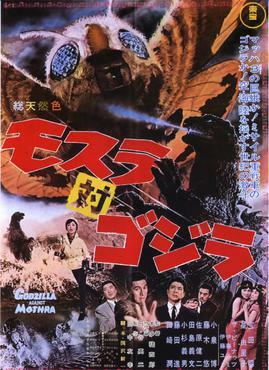A massive Mach 3 moth! The heavy missile tank Godzilla! The sky, sea, and land quake in the fierce battle of the century
In “Mothra vs. Godzilla”, two iconic kaiju, Mothra and Godzilla, engage in an epic battle that continues to thrill audiences with its classic monster showdown.
In the annals of classic kaiju cinema, “Mothra vs. Godzilla” stands as an iconic showdown that continues to captivate audiences. Released in 1964, this Japanese monster film directed by Ishiro Honda brought two legendary creatures, Mothra and Godzilla, together for an epic clash of titans. While it may not have the high-tech special effects of modern blockbusters, this film’s nostalgic charm and creative storytelling are timeless. Let’s delve into the heart of this cinematic masterpiece.
The film introduces a unique premise that sets it apart from other entries in the Godzilla franchise. A radioactive typhoon washes Godzilla ashore, providing a fresh and ominous dimension to the storyline. As Godzilla emerges from the ocean, audiences are left in awe of the suitmation techniques and miniature sets that were cutting-edge for their time. This movie was a technological marvel of its era, and it holds up remarkably well even in the digital age.
One of the film’s strongest points is its characters. The audience immediately becomes emotionally invested in the brave explorers, Tenno and Fukuda, who embark on a treacherous journey to Infant Island, the home of Mothra. Here, they encounter the mystical Shobijin, tiny twin fairies who serve as Mothra’s emissaries. Their enchanting songs and the spiritual connection between humans and monsters add a magical quality to the film, a touch rarely seen in kaiju movies.
As Mothra and Godzilla prepare for their inevitable clash, the film brilliantly builds tension and anticipation. The scale of destruction they unleash is nothing short of spectacular. The meticulous detail of the miniature cities being ravaged by the colossal creatures is a testament to the filmmakers’ dedication to their craft. Special effects wizard Eiji Tsuburaya’s work shines throughout the movie, showcasing his artistry in crafting a visually stunning and memorable showdown.
The battle sequences between Mothra and Godzilla are awe-inspiring, both in their choreography and the scale of destruction. This film is a testament to the brilliance of suitmation and practical effects, as the two monsters go toe-to-toe with impressive fluidity. The sense of weight and realism they achieve is astounding, especially when considering the technology available in the 1960s.
What sets “Mothra vs. Godzilla” apart from its contemporaries is the underlying environmental message. Mothra, a symbol of nature and preservation, faces off against the embodiment of nuclear destruction in Godzilla. This thematic depth elevates the film beyond mere monster battles, giving it a timeless relevance that continues to resonate with audiences today.
In conclusion, “Mothra vs. Godzilla” is a classic of the kaiju genre, a film that has left an indelible mark on cinema history. Its compelling story, well-developed characters, and groundbreaking special effects make it a must-watch for both kaiju enthusiasts and cinephiles. While it may lack the modern CGI of today’s blockbusters, it compensates with its heart and creativity. “Mothra vs. Godzilla” is an enduring testament to the magic of practical effects and the power of storytelling in cinema.

Cast
- Akira Takarada as Ichiro Sakai
- Yuriko Hoshi as Junko Nakanishi
- Hiroshi Koizumi as Professor Miura
- Yu Fujiki as Jiro Torahata
- Emi Ito as Shobijin (Twin Fairy)
- Yumi Ito as Shobijin (Twin Fairy)
- Kenji Sahara as Jiro Nakamura
- Jun Tazaki as Maruta
- Yoshifumi Tajima as Director-General of the JSDF
- Kenzo Tabu as Chief of staff
- Seizaburo Kawazu as Newspaper reporter
- Ren Yamamoto as Chief of Kamo Water Plant
- Ren Imaizumi as Observer A
- Shoichi Hirose as JSDF officer
- Yasuhisa Tsutsumi as JSDF officer
- Kazuo Suzuki as Man at observation
- Saburo Iketani as Villager
- Nadao Kirino as Villager
- Tetsu Nakamura as Fisherman
- Sachio Sakai as Villager
- Haruya Sakamoto as JSDF officer
- Akihiko Hirata as Reporter
- Kazuo Hinata as Police officer
- Kazuo Kumakura as JSDF officer
- Osman Yusuf as News camera operator
- Keiko Sawai as Woman at radio center
- Haruo Nakajima as Godzilla
- Masanori Shinohara as Godzilla (stunt double)
- Hiroshi Sekita as Godzilla (stunt double)
- Seiji Onaka as Mothra
- Shinji Takagi as Mothra (puppeteer)
- Masaki Shinohara as Mothra (puppeteer)
- Susumu Fujita as Villager
- Tetsuya Iwanaga as Villager
- Hiroshi Akitsu as Observer B
- Hideo Shibuya as Photographer
- Kuniyoshi Kashima as Villager
- Yoshio Kosugi as Villager
- Yasuhiko Kakuno as Villager
- Haruo Nakajima as Mothra (water puppet)
- Katsumi Tezuka as Mothra (water puppet)
- Shinichi Nakao as Villager
- Kuninori Kodo as Villager
- Yutaka Nakayama as Reporter
- Goro Manabe as JSDF officer
- Yutaka Oka as Man at Kamo Water Plant
- Shigeru Yamada as Villager
- Hisaya Ito as News camera operator
- Haruo Nakajima as Godzilla (water puppet)
- Yuji Ozaki as Bar customer

 Buy me a coffee
Buy me a coffee